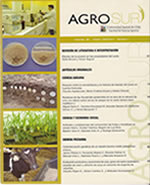Filtering capacity of soils in southern Chile to fish breeding sludge application
Main Article Content
Abstract
The behavior and effects of fish breeding sludge on soil and plants are scarcely known. This study analysed the capacity of volcanic ash soils to neutralise and filter the effects of fish breeding sludge after application. Three doses of sludge were used under controlled conditions: 30-32 t ha-1, 60-64 t ha-1 and 120-128 t ha-1 applied to 45 cm columns of soil, using three repetitions per treatment during 6 months and replicating it twice during the year: autumn-winter and spring-summer. Unlike lake or sea sludge, fish breeding sludge is high in nitrogen (7.8-11.5% dry matter) which was quickly leached as ammonium and nitrate reaching maximum values during the first month in sandy soils, exceeding the norms at all doses. In loamy soils this maximum is delayed by 4 months, also with values above the norm. The recommended maximum dose is approximately 20-25 t of raw sludge for loamy soils and 10-13 t for sandy soils. Loamy soils neutralise effectively the smell of this sludge, especially if incorporated into the soil (crop). The application of fish breeding sludge into soils significantly improves the nutritional content of nitrogen and phosphorus and, to a lesser extent, calcium, potassium, and some iron, sulfur, manganese, copper, zinc and boron.

